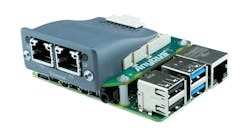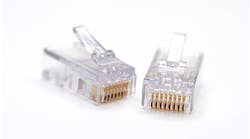Unless some special requirement is needed, stranded copper wire is almost always used to supply power and control signals to most everything we connect. The wire size selected is not always based on ampacity—the maximum conductor current capability before damage—but is often dictated by an end-user specification. Although the specification may call for all signal wires to be 14 American wire gauge (AWG) or larger, that specification was likely written when control systems consisted of banks of multi-contact relays.
A modern PLC only requires a few milliAmps to change the state of an input. Since 24 AWG (0.2 mm2) wires can easily handle 0.5 A under normal circumstances, it makes little sense to use 14 gauge wire for signal inputs to a PLC, unless of course the wires will be run long distances, as a 24 AWG wire has about 10 times the resistance that a 14 AWG wire has.
As the wires get smaller, they also get increasingly harder to handle and to apply markings. A good compromise would be to use 18 AWG or 20 AWG wire for all signaling applications. These wires are large enough to apply legible identification and to be handled by a maintenance person wearing arc-flash-protection gloves. If the power requirements are greater than that of a signal wire, then all power and temperature requirements need to be factored into wire size selection.
Also read: How wireless communication is or isn't being used by machine builders
In most cases, the type of wire used in machine control systems is machine tool wire (MTW) or thermoplastic high heat resistant nylon (THHN). THHN wire has an additional nylon coating over the main PVC insulation to protect it from water, gases and solvents. The nylon also provides a degree of resistance to abrasion, but, although it is less flexible, the slippery surface makes it easier to pull through conduit. MTW is popular for use within a control enclosure because of its flexibility, although it has a slightly larger outside diameter and less resistance to chemicals than THHN.
[pullquote]
Wiring should always be color-coded to reflect the voltage being carried by the wire and its use. Unfortunately, the world standard organizations cannot seem to agree on what the proper color of any particular wire should be. NEC, NFPA, IEC and CSA all have their own ideas of color coding. Add to this, many corporations, manufacturing plants and even individual countries enforce their own specifications.
It's critical to determine the wire color code used by the end customer before designing and wiring the control system. I personally know of several automated machines that required considerable rewiring before they were compliant with EU regulations. The electrical integrator would have saved a considerable amount of time and money had he simply checked the local requirements before finalizing the design.
In industrial installations, individual wires located outside of a control enclosure are typically housed in conduit for protection. However, cables are not always enclosed in conduit for protection; instead the cable sheathing is relied upon. The cable sheath is required to offer resistance to environmental conditions such as chemicals, heat, UV light and temperature.
Resistance to abrasion and the ability to withstand constant flexing may also need to be considered. Robotic arms can quickly destroy a cable that was not designed to withstand the constant movement and flexing. If the robot also happens to be welding, resistance to weld splatter must be included when selecting the cable.
When the cable is being used for high-speed communication signals, it is usually best to follow the recommendations of the communication equipment manufacturer. It would be safe to say that a manufacturer tests and develops speed and distance specifications of the equipment using the cabling best suited for that job.
High-speed signal and communication cable are often required to be shielded. The additional conductive shield encases the signal wires to help keep electromagnetic noise energy from interfering with the desired electrical signals. Of the two types of shielding, a foil shielded cable is less expensive and easier to install. Braded shielding holds up better to cable flex and adds strength and abrasion resistance. However, without the proper hand tools, braded shielding is more difficult to install.
All industrial control systems require good wire identification. It's not just a good practice; the system should not be accepted without wire labels on all wires. A maintenance person working on a machine should be able to find a reference number on a wire and then quickly find that wire in an electrical schematic. Wires with no identification or that do not match the drawings only adds to the time it takes to troubleshoot and repair a problem.
Cabling also needs to be identified. For the sake of the maintenance electrician, identify both ends of the cable. One project I worked on not only identified the cables on both ends, but an additional label was added to identify which control or junction box the cable was attached to. I found this feature alone saved countless hours of searching through drawings.
Homepage image courtesy of Idea go at FreeDigitalPhotos.net




